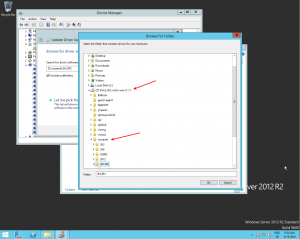Proxmox Virtio Drivers Windows
Usually using VirtIO drivers you can maximize performances, but this depends on the availability and status of guest VirtIO drivers for your guest OS and platform. Windows OS support While recent Linux kernels already have those drivers so any distribution, running in a kvm VM, should recognize virtio devices exposed by the kvm hypervisor, all current Windows OS need special drivers to use virtio. May 28, 2019 qxldod — QXL graphics driver (if installing Windows 7 or earlier, choose qxl instead) Balloon — VirtIO memory balloon driver (optional, but recommended unless your server has plenty of RAM) I believe these drivers are optional, so you only need to install if you have a specific need for them, or if you just want to be on the safe side: viorng — VirtIO RNG driver; vioser — the VirtIO serial driver. @DanielB: The VirtIO driver can be loaded in the installation process with a separate driver disc. If Windows 10 is installed with the VirtIO driver, there is no problem. It's just that the existing instructions on the Internet to switch Windows from IDE to VirtIO do not work for Windows 10 KVM virtual machines. – Deltik Apr 3 '16 at 10:51. At this stage, you will be presented with the following window. As you can see, there is no disks detected by the Setup routine. We are indeed using VIRTIO drivers. The new Setup routine make it more easy (compared to windows 2003) to specify additional drivers. On this page, you can click on the Load Driver option. Click to Enlarge. If your distribution does not provide binary drivers for Windows, you can use the package from the Fedora Project. These drivers are digitally signed, and will work on 64-bit versions of Windows: Latest VirtIO drivers for Windows from Fedora. Code signing drivers for the Windows 64bit platforms. Drivers should be signed for Windows 64bit platforms. Qxldod — QXL graphics driver (if installing Windows 7 or earlier, choose qxl instead) Balloon — VirtIO memory balloon driver (optional, but recommended unless your server has plenty of RAM) I believe these drivers are optional, so you only need to install if you have a specific need for them, or if you just want to be on the safe side: viorng — VirtIO RNG driver; vioser — the VirtIO serial driver.
This repository contains KVM/QEMU Windows guest drivers, for bothparavirtual and emulated hardware. The code builds and ships as partof the virtio-win RPM on Fedora and Red Hat Enterprise Linux, and thebinaries are also available in the form of distribution-neutral ISOand VFD images. If all you want is use virtio-win in your Windowsvirtual machines, go to theFedora virtIO-win documentationfor information on obtaining the binaries.
How to Create a Mac Recovery USBWhen you clone the recovery volume on any partitions listed in 'Disk Utility', any data in the destination volume will be deleted. And remember that these instructions will not work if you have an older device model that is currently running on a newer operating system.Part 2. Go to Applications Utilities to see if the 'Recovery Disk Assistant' is not available in the folder. Apple recovery partition windows 7. Therefore, it is a good idea to prepare the USB drive before you create OS X Recovery drive with Disk Assistant, especially a USB drive with a large amount of storage space. Create partitions in the new destination so that you will be able to have a dedicated section for the recovery volume.Once you have prepped the new destination,if needed, follow these steps to get you on the way of owning a physical OS X Recovery disk created with Disk Assistant.Get the Disk Assistant, if neededWhere is Recovery Disk Assistant?

If you'd like to build virtio-win from sources, clone this repo andfollow the instructions in Building the Drivers.Note that the drivers you build will be either unsigned or test-signedwith Tools/VirtIOTestCert.cer, which means that Windows will not loadthem by default. See Microsoft's driver signing pagefor more information on test-signing.
Proxmox Windows Vm Drivers
If you want to build cross-signed binaries (like the ones that ship inthe Fedora RPM), you'll need your own code-signing certificate.Cross-signed drivers can be used on all versions of Windows except forthe latest Windows 10 with secure boot enabled. However, systems withcross-signed drivers will not receive Microsoft support.

Proxmox Windows Drivers
If you want to produce Microsoft-signed binaries (fully supported,like the ones that ship in the Red Hat Enterprise Linux RPM), you'llneed to submit the drivers to Microsoft along with a set of testresults (so called WHQL process). If you decide to WHQL the drivers,make sure to base them on commit eb2996de or newer, since the GPLlicense used prior to this commit is not compatible with WHQL.Additionally, we ask that you make a change to the Hardware IDs sothat your drivers will not match devices exposed by the upstreamversions of KVM/QEMU. This is especially important if you plan todistribute the drivers with Windows Update, see theMicrosoft publishing restrictions for more details.